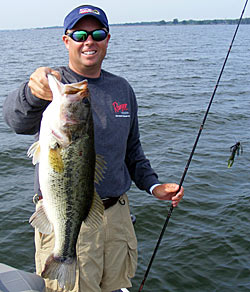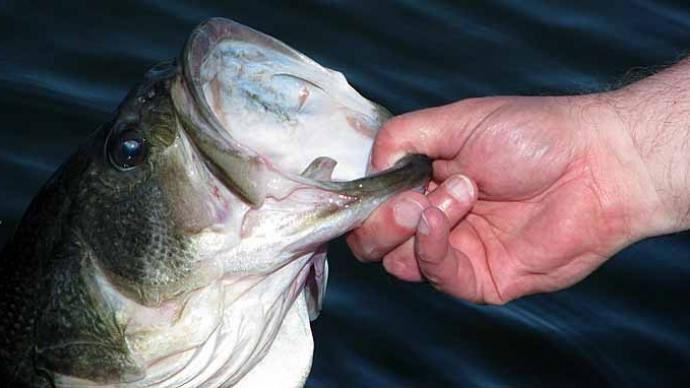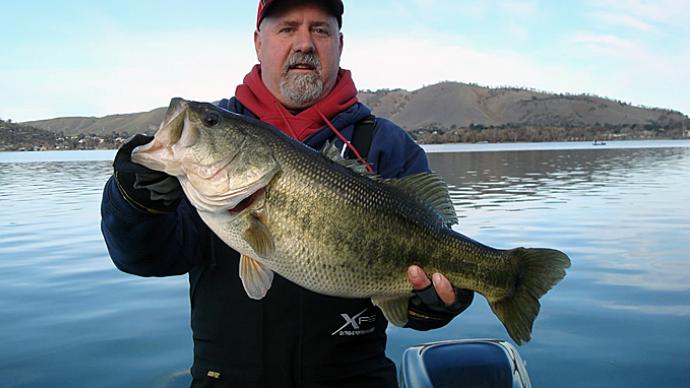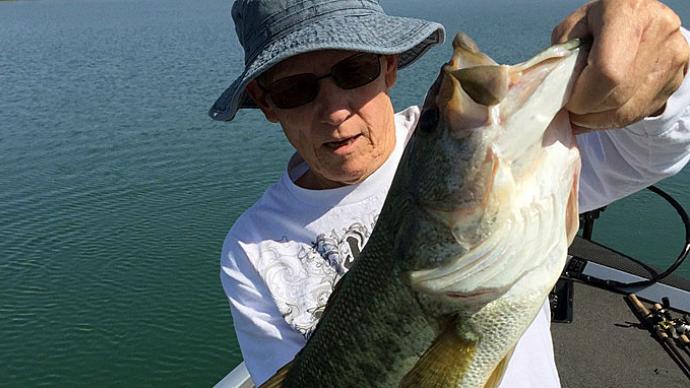
If one of your goals is to catch your biggest bass ever, or if you're looking to catch big fish regularly, here are a few tips that I've learned over the years.
Timing: When planning a trip well in advance, try to schedule your trophy trips for times that have big fish most accessible while also matching your fishing style. Prespawn is the undisputed best time on most lakes to catch the year's biggest bass. Running from January through March on Lake Fork (Texas), not only are bass at their highest weights for the year, almost all of the fish in the lake are concentrated in 10' of water or less. This combination of heavy fish in small lake areas makes it the shallow water fisherman's dream, with jigs, spinnerbaits, and swimbaits being top producers.
The spawn is also a great option if you prefer sight fishing or fishing weightless soft plastics like Magic Shads in the shallows. May through July is an ideal time for deep-water fishermen to catch schools of monster bass on deep structures.
When scheduling trips to nearby lakes on short notice, try to pick the days with ideal conditions. We all know that the day of a big front can result in incredible fishing. I've had many of my best lunker days on the cold, rainy, and windy days after severe cold fronts. Although windy conditions can be unpleasant for anglers after a front, the water usually takes a day to cool considerably, resulting in a good bite until the skies finally clear and the wind lays down.
Speaking of sunny and calm, those are comfortable days to be in the boat, but I usually find the bite to be a lot better on windy and cloudy days. Finally, the best scenario for a bass fisherman is stable conditions. If the water and the weather conditions stay the same for several days, the best pattern will typically stay the same. As a result, once you figure out the fish, you can duplicate your results until the conditions change. Big fronts make for great fishing for a few hours, while stable conditions can make for great fishing for days.
Fishing Style: The best advice I can give you when hunting lunkers is to come early and stay late. It sounds rather simplistic, but there is usually a particular time each day when the fish seem to be "on." Some days the active period lasts for a long time. Other days it is a short window. Regardless, if you're not fishing when the bass are actively biting, you've missed your best window of opportunity.
During your time on the lake, focus on slightly deeper water and fish key areas very thoroughly. Even when I catch big bass in the very backs of creeks, they're typically near quick access to deep water or holding slightly deeper than most of the bass in the area. Especially in the springtime, your odds of catching a true lunker go up dramatically if you remain two casts away from shore, throwing into the area where most of the boats fishing the shore are setting. Once you find an area holding big fish, work it over very thoroughly.
In my experience, productive big fish areas produce each season consistently. I'll check them several times a day with different lures in my key spots, making repeated casts to likely areas. It never ceases to amaze me that big fish will often bite after you've already made thirty or forty casts in the area. I'm not sure what eventually triggers those fish to bite, but I do know that if you keep your lure in front of big fish long enough, good things happen.
If you're perceptive, you probably wonder how long to commit to a single spot. There's a fine line in fishing between persistence and stubbornness. Throwing a big swimbait or pitching a jig all day for a few big bites is being persistent; not getting a single bump all days tells me that I'm being stubborn and not giving the fish what they want.
I've never subscribed to the theory that big fish are loners and that if you're going for trophy bass, you're fishing for one bite a day. In most cases, I catch my fish over ten pounds on days when I'm getting regular bites from five to eight-pound bass. If I'm catching quality fish of this size or at least getting bites from them every hour or two, it tells me I'm appealing to bigger bass and sticking with the pattern. If I've fished for six hours on Fork and caught a couple of fives, a six and a half, and an eight, I feel pretty confident that a lunker could come on anycast. Conversely, if I've gone that time without a bite or caught twenty-five fish, but none have been over three pounds, I figure that I'm not appealing to big bass, and it's time to adjust my pattern.
Lures: While many lures and techniques will catch big bass, I have a few basic lures that catch the lion's share of my trophies. First and foremost, a Mega Weight jig with a matching Fork Craw trailer produces big fish, both shallow and deep, year-round. Big bass love the heavy cover, and you can bring a jig through the nastiest wood or grass where the lunkers are hiding. On those post-frontal days, I often find bass pulling back from the flats and forming tight schools in creek channel bends or on points. Thoroughly work a jig in these areas. You can catch multiple big fish from a tiny area.
When bass are up on the flats and chasing, a big spinnerbait slow rolled around grass and wood allows you to cover more water than a jig while still appealing to big bass. I prefer big three-quarter to one-and-a-half-ounce spinnerbaits for lunkers, with a full-sized trailer like a Baby Fork Creature or a four-and-a-half-inch Live Magic Shad. Spinnerbaits are usually the first bait I'll grab if it's rainy or windy in the spring.
In recent years, big swimbaits have become major lunker producers due to their lifelike swimming motion and large size. Whether shallow or deep, I'll always give big swimbaits a try when I'm shooting for monster bass. My current favorite is the five-and-a-half-inch and the giant eight-inch Live Magic Shads from Lake Fork Trophy Lures. By simply adding weight to a large wide gap hook, I can fish these swimbaits super slow to super fast in from one to thirty feet of water.
The common denominator among all these lures is that I can fish all of them very slowly and bring them through heavy cover. While the occasional erratic stop-and-go can trigger a bass to strike, slow retrieves and even leaving a bait motionless is the best retrieve for big fish.
Hopefully, these few tips stack the odds in your favor for catching a lot of big fish this season. Here's hoping you catch the lunker of your dreams.




